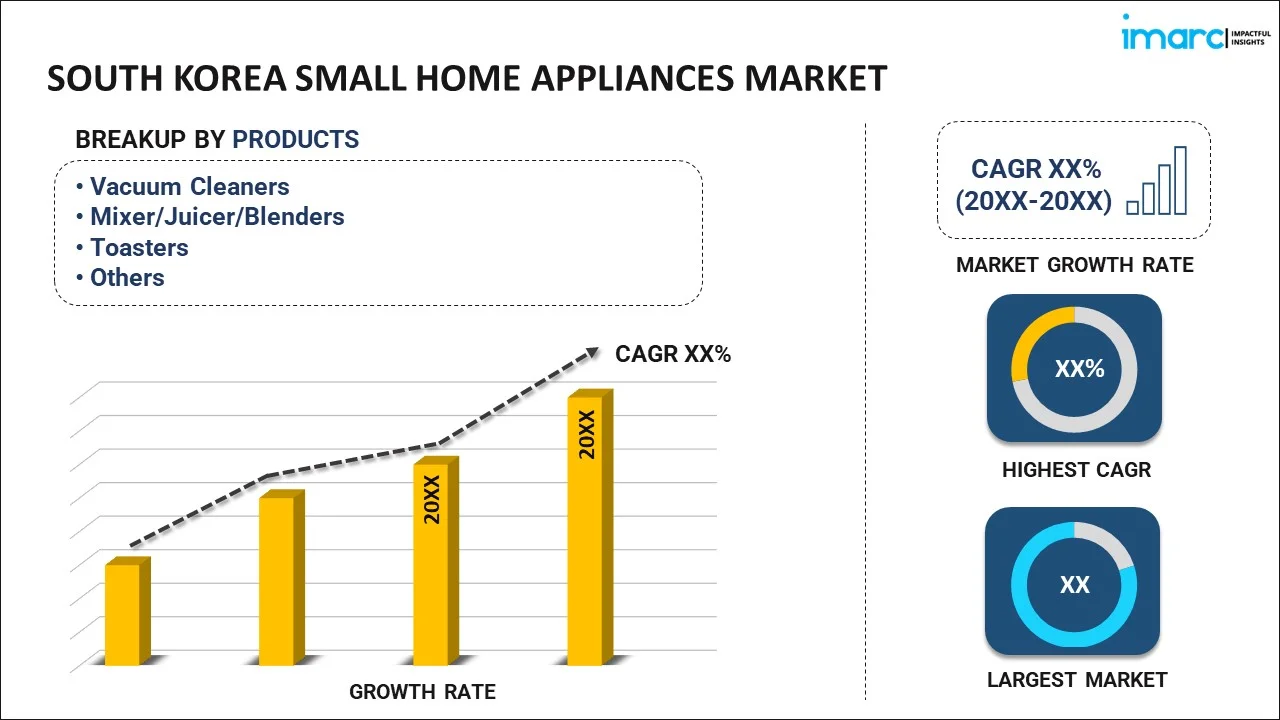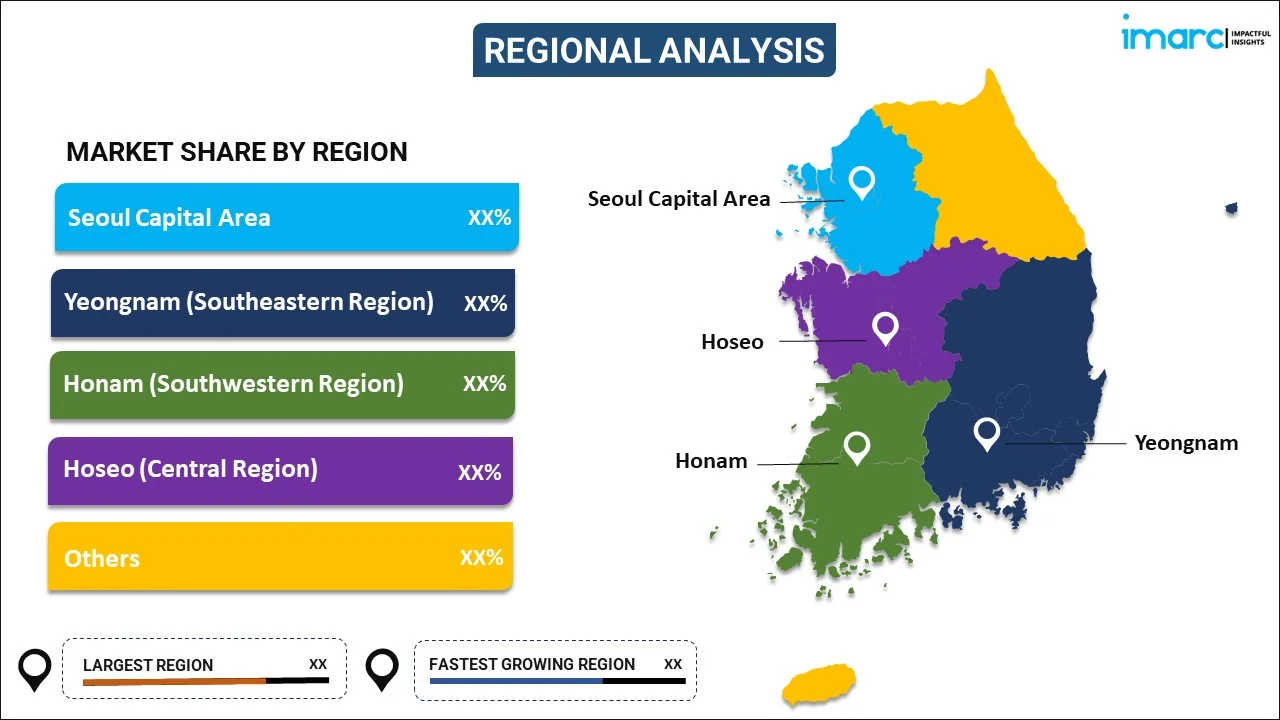
South Korea Small Home Appliances Market Report by Product (Vacuum Cleaners, Mixer/Juicer/Blenders, Toasters, Coffee Machines, Air Purifiers, and Others), Distribution Channel (Multibrand Stores, Exclusive Stores, Online, and Others), and Region 2026-2034
Market Overview:
South Korea small home appliances market size reached USD 2.5 Billion in 2025. Looking forward, IMARC Group expects the market to reach USD 3.7 Billion by 2034, exhibiting a growth rate (CAGR) of 4.70% during 2026-2034. The significant technological advancements, rapidly changing lifestyles, energy efficient, rapid urbanization, growing trends of health and wellness, increasing e-commerce and online shopping, favorable government initiatives, and brand reputation regulatory compliance represent some of the key factors driving the market.
|
Report Attribute
|
Key Statistics
|
|---|---|
|
Base Year
|
2025
|
|
Forecast Years
|
2026-2034
|
|
Historical Years
|
2020-2025
|
|
Market Size in 2025
|
USD 2.5 Billion |
|
Market Forecast in 2034
|
USD 3.7 Billion |
| Market Growth Rate 2026-2034 | 4.70% |
Access the full market insights report Request Sample
Small home appliances are compact, convenient, and versatile devices designed to make daily tasks easier and more efficient. These appliances are an integral part of modern households, contributing to the comfort and functionality of living spaces. Small home appliances encompass a wide range of products, including kitchen appliances like blenders, toasters, coffee makers, and microwaves, which streamline meal preparation. Additionally, they include cleaning appliances, such as vacuum cleaners, steam irons, and electric brooms, which aid in maintaining a tidy and hygienic home environment. Furthermore, small home appliances extend to personal care items like hairdryers, electric shavers, and electric toothbrushes,. These devices are characterized by their compact size, user-friendly interfaces, and often energy-efficient operation. Small home appliances save time and effort, and also contribute to energy conservation and sustainability. With advancements in technology, numerous small home appliances are equipped with smart features, allowing users to control them remotely via mobile apps or voice commands.
South Korea Small Home Appliances Market Trends:
Evolving lifestyles and demographics, including smaller households and increasing working professionals, have led to a greater demand for time-saving and convenient solutions. Small home appliances that simplify daily tasks, like coffee makers for busy mornings or robotic vacuum cleaners for efficient cleaning, are in high demand. Additionally, with a growing focus on sustainability and energy conservation, energy-efficient small home appliances are gaining popularity. Consumers in South Korea are becoming increasingly conscious of carbon footprint, making appliances with high energy-efficiency ratings more appealing. Other than this, the rising urbanization rate in South Korea has led to smaller living spaces in cities like Seoul. As a result, compact and space-saving appliances have become essential for maximizing the utility of limited living areas. Besides this, an increasing awareness about health and wellness has accelerated the sales of appliances like blenders and juicers, enabling consumers to prepare nutritious meals and beverages at home. In line with this, the emerging e-commerce platforms has made it easier for consumers to access a wide variety of small home appliances. This has expanded product availability and enabled consumers to make informed choices based on reviews and comparisons. The increasing adoption of smart home technology has led to a surge in the demand for small home appliances that can be controlled and monitored remotely through smartphone apps. This convenience and connectivity are appealing to modern consumers. Furthermore, the government of South Korea has introduced initiatives to promote energy efficiency and reduce greenhouse gas emissions. This has encouraged consumers to choose energy-efficient appliances, further boosting the market for such products. Moreover, the COVID-19 pandemic has heightened awareness about hygiene and cleanliness, resulting in increased demand for small home appliances like air purifiers and sterilizers, especially in densely populated urban areas.
South Korea Small Home Appliances Market Segmentation:
IMARC Group provides an analysis of the key trends in each segment of the market, along with forecasts at the country level for 2026-2034. Our report has categorized the market based on product and distribution channel.
Product Insights:

To get detailed segment analysis of this market Request Sample
- Vacuum Cleaners
- Mixer/Juicer/Blenders
- Toasters
- Coffee Machines
- Air Purifiers
- Others
The report has provided a detailed breakup and analysis of the market based on the product. This includes vacuum cleaners, mixer/juicer/blenders, toasters, coffee machines, air purifiers, and others.
Distribution Channel Insights:
- Multibrand Stores
- Exclusive Stores
- Online
- Others
A detailed breakup and analysis of the market based on the distribution channel have also been provided in the report. This includes multibrand stores, exclusive stores, online, and others.
Regional Insights:

To get detailed regional analysis of this market Request Sample
- Seoul Capital Area
- Yeongnam (Southeastern Region)
- Honam (Southwestern Region)
- Hoseo (Central Region)
- Others
The report has also provided a comprehensive analysis of all the major regional markets, which include Seoul Capital Area, Yeongnam (Southeastern Region), Honam (Southwestern Region), Hoseo (Central Region), and others.
Competitive Landscape:
The market research report has also provided a comprehensive analysis of the competitive landscape in the market. Competitive analysis such as market structure, key player positioning, top winning strategies, competitive dashboard, and company evaluation quadrant has been covered in the report. Also, detailed profiles of all major companies have been provided.
South Korea Small Home Appliances Market Report Coverage:
| Report Features | Details |
|---|---|
| Base Year of the Analysis | 2025 |
| Historical Period | 2020-2025 |
| Forecast Period | 2026-2034 |
| Units | Billion USD |
| Scope of the Report | Exploration of Historical and Forecast Trends, Industry Catalysts and Challenges, Segment-Wise Historical and Predictive Market Assessment:
|
| Products Covered | Vacuum Cleaners, Mixer/Juicer/Blenders, Toasters, Coffee Machines, Air Purifiers, Others |
| Distribution Channels Covered | Multibrand Stores, Exclusive Stores, Online, Others |
| Regions Covered | Seoul Capital Area, Yeongnam (Southeastern Region), Honam (Southwestern Region), Hoseo (Central Region), Others |
| Customization Scope | 10% Free Customization |
| Post-Sale Analyst Support | 10-12 Weeks |
| Delivery Format | PDF and Excel through Email (We can also provide the editable version of the report in PPT/Word format on special request) |
Key Questions Answered in This Report:
- How has the South Korea small home appliances market performed so far and how will it perform in the coming years?
- What has been the impact of COVID-19 on the South Korea small home appliances market?
- What is the breakup of the South Korea small home appliances market on the basis of product?
- What is the breakup of the South Korea small home appliances market on the basis of distribution channel?
- What are the various stages in the value chain of the South Korea small home appliances market?
- What are the key driving factors and challenges in the South Korea small home appliances?
- What is the structure of the South Korea small home appliances market and who are the key players?
- What is the degree of competition in the South Korea small home appliances market?
Key Benefits for Stakeholders:
- IMARC’s industry report offers a comprehensive quantitative analysis of various market segments, historical and current market trends, market forecasts, and dynamics of the South Korea small home appliances market from 2020-2034.
- The research report provides the latest information on the market drivers, challenges, and opportunities in the South Korea small home appliances market.
- Porter's five forces analysis assist stakeholders in assessing the impact of new entrants, competitive rivalry, supplier power, buyer power, and the threat of substitution. It helps stakeholders to analyze the level of competition within the South Korea small home appliances industry and its attractiveness.
- Competitive landscape allows stakeholders to understand their competitive environment and provides an insight into the current positions of key players in the market.
Need more help?
- Speak to our experienced analysts for insights on the current market scenarios.
- Include additional segments and countries to customize the report as per your requirement.
- Gain an unparalleled competitive advantage in your domain by understanding how to utilize the report and positively impacting your operations and revenue.
- For further assistance, please connect with our analysts.
 Request Customization
Request Customization
 Speak to an Analyst
Speak to an Analyst
 Request Brochure
Request Brochure
 Inquire Before Buying
Inquire Before Buying




.webp)




.webp)












